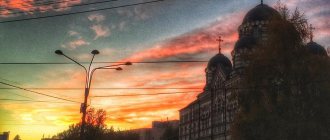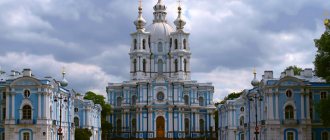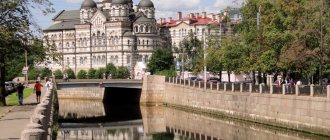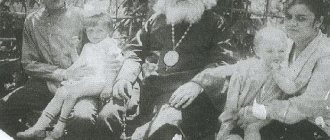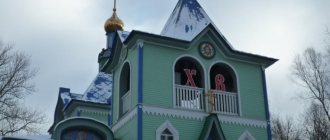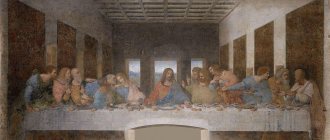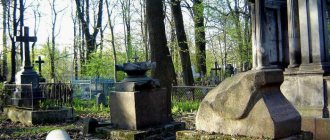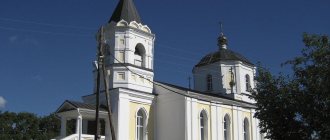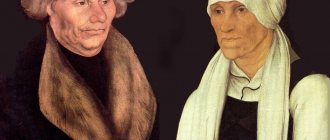The cultural capital of Russia, St. Petersburg, has traditionally been one of the centers of the country's spiritual life. In the city and its surroundings there are numerous religious centers: ancient temples and monasteries with world-famous Christian relics.
The history of the northern capital is also inextricably linked with especially revered Christian saints, such as Alexander Nevsky, John of Kronstadt, Ksenia of Petersburg and Alexander Svirsky.
In St. Petersburg and the Leningrad region there are currently more than 450 cathedrals and churches, about 20 active monasteries and monastic farmsteads, 18 holy springs, so it is not surprising that this region has become a center of pilgrimage and religious tourism.
Alexander Nevsky Lavra
Traveling to holy places to venerate the relics of saints and miraculous icons is an ancient tradition of Russian Orthodoxy, helping believers receive spiritual support and become familiar with the religious and cultural values that are so necessary in modern life.
Pilgrimage trips are organized, as a rule, by special pilgrimage organizations that have an agreement with the bodies of the Russian Orthodox Church. Travel companies offer historical and religious excursions with visits to holy places as part of a group.
You can make such a trip on your own, even without a personal car, because some significant objects are located within the city limits or in the immediate vicinity and can be reached using public transport.
Saint Isaac's Cathedral
St. Isaac's Cathedral, one of the first cathedrals, was founded in the same days as the Northern capital itself, under Peter 1. It acquired its modern appearance under Tsar Alexander 1, when it was rebuilt according to the design of the architect Montferrand.
When one of the first holy places in St. Petersburg was consecrated, the Holy Synod donated shrines with a piece of the Holy Cross and an ark with a piece of the relics of the Apostle Andrew the First-Called.
An icon with a particle of the relics of St. Panteleimon was brought from Athos in 1871.
The Miraculous Image of the Savior, painted in 1693, is considered miraculous; Emperor Peter I prayed before it.
In this holy place of St. Petersburg there is a revered copy of the Tikhvin Icon of the Mother of God.
In 2021, the Church presented St. Isaac's Cathedral with the relics of Saints Nicholas the Wonderworker and Spyridon of Triminfutsky, the apostles Peter, Paul and Andrew the First-Called. They are kept in the Alexander Nevsky chapel and taken out every morning.
Alexander Nevsky Lavra
One of the famous holy places of St. Petersburg is the Alexander Nevsky Lavra. It was built on the site of the battle with the Swedes in 1241 by order of Peter the Great. Here are collected the relics of the Kiev-Pechersk saints, St. Innocent of Irkutsk, Alexander Nevsky.
You can pray before the icon of the Mother of God “Neva Quick to Hear”, brought from Athos, the holy martyr Paraskeva Friday, St. Seraphim of Sarov and other shrines.
The great commander A. Suvorov is buried in the Alexander Nevsky Lavra.
Who should not go to the relics
As the chairman of the department for relations between church and society of the St. Petersburg diocese, Archpriest Alexander Pelin to the Federal News Agency , most likely, atheists and skeptics have nothing special to do in line to see the relics. People go to a shrine first of all in order to feel God’s invisible grace on themselves through visible signs, and for this you need to want to feel it.
As the archpriest noted, during the visit to the relics and prayer to the saint, “people will be given what they ask for according to their faith.”
Kazan Cathedral
Under Alexander 1 in 1801, the Kazan Cathedral was founded on the site of the Nativity Church. Its visit is included in the program of any trips to the holy places of St. Petersburg.
The temple was specially built to store the miraculous Kazan Icon of the Mother of God. In 1812, it became a repository of trophies of the Great Patriotic War, army banners of Napoleonic troops, keys to conquered cities, and in 1813 Field Marshal M.I. Kutuzov was buried in the cathedral.
It immediately became a famous holy place in St. Petersburg, helping in arranging marriages and healing eye diseases. In front of the Kazan Icon they also prayed for the protection of the Fatherland from enemies.
After the revolution, the cross was removed from the temple, in its place a gilded ball with a spire was installed, and later the Museum of the History of Religion was opened in the church.
During the war, the temple was damaged by bombing, then major repairs were carried out.
In 1991, with the beginning of the revival of Orthodoxy in Russia, it was opened for worship and became one of the significant holy places in St. Petersburg and throughout Russia. Today it is the central cathedral.
The cathedral opens daily at 6.30, Liturgy and confession begin at 7.00, the second Liturgy at 10.00. Closes after the end of the evening service.
Church of the Holy Righteous Job the Long-Suffering
The only church in the North-West of St. Job, a character from the Old Testament. Job was rich and had beautiful daughters, but Satan demanded that God test the righteous man. Then God took everything from Job and doomed him to suffering and torment, after which he rewarded him threefold. Interesting fact: this temple never stopped working, even during the days of the siege. Location: Kamchatskaya street, building 6, Volkovo Orthodox cemetery
Chapel of Xenia the Blessed
During her lifetime, Xenia the Blessed gained fame and people's love through her service to God and people and her amazing gifts of grace. She often appeared in visions: she warned of danger and saved from disasters.
The absence of children is a great cause for sadness for many couples. Year after year goes by, and pregnancy does not occur even with access to the most modern medical capabilities. It is no secret that prayer to God often helps to give birth to a long-awaited child. The holy place in St. Petersburg that helps you get pregnant is the Chapel of Xenia the Blessed.
Having lost her beloved husband at the age of 26, Ksenia severed all ties with worldly life, devoting her life to serving God. She distributed all her property to the poor. During the day she wandered around the city in her husband’s uniform, and at night she went to deserted places and prayed. She was always invited to go to trading stores, since many buyers appeared after her, and people often turned to her for healing. During her lifetime, she helped in arranging marriages, finding children, finding work, and had the gift of prophecy.
Now Ksenia often comes in dreams to those who turn to her with prayers, warning of danger.
During her lifetime, the people revered her as a saint, although she was officially canonized only in 1988. Xenia the Blessed was buried at the Smolensk cemetery not far from the Smolensk Church. Her grave is now located under a stone mound in the chapel, which was erected in 1902. Inside there is a mosaic icon of Blessed Xenia.
For a long time, the tradition has been preserved of leaving notes with wishes on her grave within the walls of the chapel.
It is open daily; in summer – from 10.00 to 17.00, in winter – from 10.00 to 16.00.
Temple of the Smolensk Mother of God
One of the healing holy places in St. Petersburg is the Temple of the Smolensk Mother of God, which is located near the Chapel of Xenia the Blessed at the Smolensk cemetery.
Getting here is easy. Minibuses go here from Vasileostrovskaya metro station. According to legend, Blessed Xenia helped carry stones during the construction of the church.
The shrine of the temple is a copy of the miraculous icon of the Smolensk Mother of God “Hodegetria” and the relics of the great saint Alexander of Svir, to whom people turn for healings.
Divine Liturgy is celebrated daily at 8:00, evening worship at 17:00. On Sundays there are two services - early at 7:00 and late at 9:30; evening service - at 17:00.
In front of the Hodegetria icon, they ask for blessings on the journey; the Mother of God will help them find their path in life. Akathist service is held on Fridays.
On Sunday evenings, an akathist is read in front of the “Vsetsaritsa” icon; it is believed that turning to the Mother of God in front of this icon helps in the treatment of cancer.
Ioannovsky Monastery
One of the holy places in St. Petersburg that helps to heal is the Ioannovsky Monastery on the Karpovka embankment.
Saint John of Kronstadt served in St. Andrew's Cathedral in Kronstadt, near St. Petersburg. A huge number of beggars lived here, and crime flourished. The priest walked through the poorest neighborhoods, preached, and served prayer services in houses for the healing of the sick.
It was soon noticed that the most seriously ill patients were healed by the shepherd’s prayers. Those suffering from alcoholism were freed from severe addiction. People began to gather for services at St. Andrew's Cathedral in the thousands. Huge sums of money were donated to him, he received envelopes with donations and distributed them in the evening, without even counting them. There is evidence that people often received exactly the amounts that they asked God for some needs. With the funds raised, he built the “House of Diligence.”
Confessions lasted for hours, he often held general confessions, in which thousands of people shouted out their sins at the same time, since there was no way to confess everyone in turn. During the visit to Kharkov, 60,000 people gathered for the service.
In 1899, he founded the Ioannovsky Monastery on the Karpovka River, in which he was buried under a blanket on the lower floor.
He had the gift of foresight and predicted many events coming in Russia. He wrote several books and composed many amazing prayers.
Pilgrims from all over the world come to venerate the tomb of St. John of Kronstadt, talk about their needs, and ask for healing. A special grace is present in this place; the soul immediately becomes joyful and light, and every person who prays is sure to receive an answer to their prayers.
What to take with you
Pilgrimage organizers advise taking water with you, dressing for the weather and having hats. Pilgrims are also advised to carry the medications they usually use.
Toilets and points of sale of food and drinks will be organized in places where pilgrims gather, but from Moscow experience we advise you to take with you a reasonable amount of food for a snack, and if you intend to spend the night in line, tourist “foams”, inflatable mattresses and pillows, as well as folding chairs . Thermos with warm drinks, warm clothes and rain capes will not be superfluous - summer is not too pampering for St. Petersburg residents yet.
Church of the Icon of the Mother of God “Joy of All Who Sorrow”
The miraculous image of the Mother of God “Joy of All Who Sorrow” (with pennies) was brought to St. Petersburg by Peter 1’s sister Natalya Alekseevna. From her house she made a house church, a shelter for the poor, and later an orphanage was organized here. The king loved to come here to visit his sister.
In 1888, during a thunderstorm, lightning struck the chapel, the icon was not damaged, but coins from the church mug stuck to it, and ten years later the church was rebuilt.
“Robe for the naked” and “healing for the sick” are given through the prayers of the Mother of God in front of the miraculous icon.
Is it possible to be cured by venerating the relics?
You will most likely not be cured, but it is quite possible to receive a positive spiritual charge for recovery. However, a pilgrimage to the relics does not replace medications, procedures and recommended surgeries prescribed by doctors.
Federal News Agency / Boris Grishin
Feodorovsky Cathedral
Feodorovsky Cathedral was built in 1913 in memory of the 300th anniversary of the reign of the House of Romanov. After the revolution there was a dairy factory there. The service began here again only in 1993. And it was completely revived in the year of the 400th anniversary of the Romanov imperial dynasty. In front of the icon they pray for the gift of children and assistance in childbirth.
The holy places of St. Petersburg and the Leningrad region are included in many tourist and pilgrimage routes. You can go on a two-day excursion to the Northern capital and Valaam; tourists stay overnight in a hotel, spend the first day in the city, and the next day go to the island in the morning.
One day on an excursion to the holy places of St. Petersburg, of course, is not enough: there are so many places worthy of visiting.
How long to queue
In Moscow, depending on the day of the week and the time when the queue was busy, the wait ranged from 8-10 to 22 hours. So in St. Petersburg you need to count on at least five to six hours of standing, and possibly more. Most likely, some pilgrims, especially visitors, will line up early at night in order to approach the shrine in the morning.
Federal News Agency / Boris Grishin

